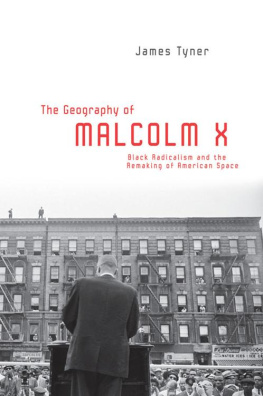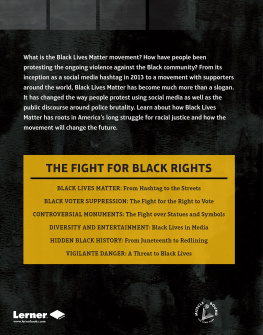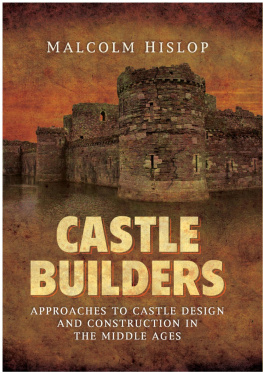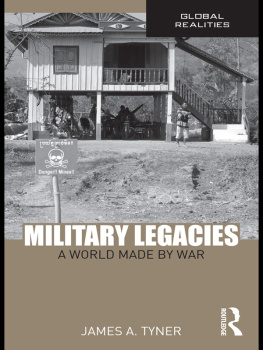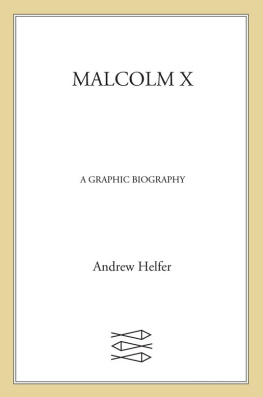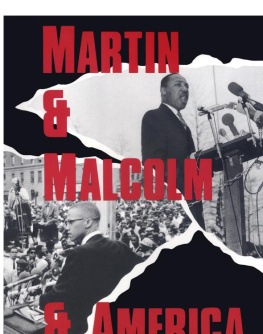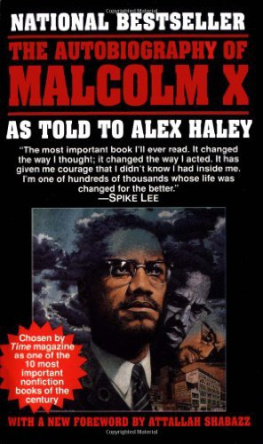James Tyner - The Geography of Malcolm X
Here you can read online James Tyner - The Geography of Malcolm X full text of the book (entire story) in english for free. Download pdf and epub, get meaning, cover and reviews about this ebook. year: 2013, publisher: Taylor and Francis, genre: Art. Description of the work, (preface) as well as reviews are available. Best literature library LitArk.com created for fans of good reading and offers a wide selection of genres:
Romance novel
Science fiction
Adventure
Detective
Science
History
Home and family
Prose
Art
Politics
Computer
Non-fiction
Religion
Business
Children
Humor
Choose a favorite category and find really read worthwhile books. Enjoy immersion in the world of imagination, feel the emotions of the characters or learn something new for yourself, make an fascinating discovery.
- Book:The Geography of Malcolm X
- Author:
- Publisher:Taylor and Francis
- Genre:
- Year:2013
- Rating:5 / 5
- Favourites:Add to favourites
- Your mark:
- 100
- 1
- 2
- 3
- 4
- 5
The Geography of Malcolm X: summary, description and annotation
We offer to read an annotation, description, summary or preface (depends on what the author of the book "The Geography of Malcolm X" wrote himself). If you haven't found the necessary information about the book — write in the comments, we will try to find it.
The Geography of Malcolm X — read online for free the complete book (whole text) full work
Below is the text of the book, divided by pages. System saving the place of the last page read, allows you to conveniently read the book "The Geography of Malcolm X" online for free, without having to search again every time where you left off. Put a bookmark, and you can go to the page where you finished reading at any time.
Font size:
Interval:
Bookmark:
James Tyner

Published in 2006 by
Routledge
Taylor & Francis Group
605 Third Avenue New York, NY10017
Published in Great Britain by
Routledge
Taylor & Francis Group
2 Park Square, Milton Park, Abingdon, Oxon OX14 4RN
2006 by James A. Tyner
Routledge is an imprint of Taylor & Francis Group
10 9 8 7 6 5 4 3 2 1
International Standard Book Number-10: 0-415-95122-4 (Hardcover) 0-415-95123-2 (Softcover)
International Standard Book Number-13: 978-0-415-95122-7 (Hardcover) 978-0-415-95123-4 (Softcover)
DOI: 10.4324/9781315810805
Library of Congress Card Number 2005015708
No part of this book may be reprinted, reproduced, transmitted, or utilized in any form by any electronic, mechanical, or other means, now known or hereafter invented, including photocopying, microfilming, and recording, or in any information storage or retrieval system, without written permission from the publishers.
Trademark Notice: Product or corporate names may be trademarks or registered trademarks, and are used only for identification and explanation without intent to infringe.
Library of Congress Cataloging-in-Publication Data
Tyner, James A., 1966
The geography of Malcolm X: black radicalism and the remaking of American space / James Tyner.
p. cm.
Includes bibliographical references and index.
ISBN 0-415-95122-4 (alk. paper) -- ISBN 0-415-95123-2 (pbk.: alk. paper)
1. African Americans--Politics and government. 2. African Americans--Intellectual life. 3. X, Malcolm, 1925-1965--Political and social views. 4. Radicalism--United States. 5. Public spacesPolitical aspects--United States. 6. Geography--Political aspects--United States. 7. African American philosophy. 8. African Americans--Social conditions. 9. Social justice--United States. 10. United States--Race relations. I. Title.
E185.61.T97 2005
305.896'073--dc22
2005015708

Visit the Taylor & Francis Web site at http://www.taylorandfrancis.com
and the Routledge Web site at http://www.routledge-ny.com
To Belinda
To some of my colleagues, this book appears to be a departure from my earlier work. Indeed, on the surface, a book on Malcolm X and black radicalism seems a rather startling diversion from my previous work on labor migration from the Philippines. However, this work actually constitutes a continuation of my broader concern with the disciplining of society through the regulation of space. As such, this present work demonstrates my attempt to understand and challenge the oppressive structures that limit the realization of the human experience. And now, I must find the space to acknowledge my friends and colleagues who have helped me over the years.
First and foremost, I thank Dave McBride at Routledge for his support, guidance, patience, and vision in seeing this book to completion. This book would not have been possible without his efforts. I thank also the many editors and reviewers who have been associated with my work on Malcolm X, both known and anonymous, for their comments, criticisms, and support: Don Mitchell, Rod Bush, Jamie Peck, Adam Tickell, Audrey Kobayashi, John Frazier, and Elizabeth Leppman. Their professionalism is sincerely appreciated.
Thanks go out to the many colleagues who have helped me over the years: Curt Roseman, Michael Dear, Laura Pulido, Stuart Aitken, Gary Peters, Mona Domosh, Richard Wright, Victoria Lawson, Ruth Wilson Gilmore, Jennifer Wolch, and Keith Collins. And while many of these people did not directly contribute to the workings of this book, their inspiration and insights on Geography continue to shape my own personal and professional transformations. Over the years I have been fortunate to work with a number of graduate and undergraduate students, all of whom have shaped me as a scholar (for better or for worse): Rob Kruse, Joshua Inwood, Aron Massey, Steve Oluic, Stacy Wicker, Steve Butcher, Donna Houston, Olaf Kuhlke, Gabe Popescue, Sutapa Chattopadhyay, Rob Schwartz, Scott Hutka, Quentin Scott, Patrick Davis, Monika Flaschka, Rachel Oley, Kamaria Wolf. Special thanks are also extended to my chair, Jay Lee.
I was fortunate to have the opportunity to present my ideas on Malcolm X and black radical thought at the following conferences and institutions: The 2004 Race, Place, and Ethnicity Conference at Howard University; the 10th Annual Critical Geography Mini-Conference at the University of Illinois; the 2002 Conference of the Southeast Division of the Association of American Geographers; the Soup & Substance Dialogue Series at Kent State University; and the Geography Department at Ball State University.
The following articles have been revised for inclusion here and appear with permission. I am sincerely grateful to the editors and journals: Geography, Ground-Level Reality, and the Epistemology of Malcolm X, Journal of Geography 102 (2003): 16778; Territoriality, Social Justice and Gendered Revolutions in the Speeches of Malcolm X, Transactions of the Institute of British Geographers NS 29 (2004): 33043; Defend the Ghetto: Space and the Urban Politics of the Black Panther Party, Annals of the Association of American Geographers (forthcoming).
I thank also my family: Dr. Gerald Tyner, Dr. Judith Tyner, David Tyner, Floris Tyner, Karen Owens, and Bill Owens. Each, in his or her own way, has helped me mature as a person, a father, and a professor. These brief sentences can in no way cover my thanks. As always, heartfelt thanks are extended to Bond (my puppy) and Jamaica (my cat), for their constant companionship. Together, they remind me of what is really important while writing a book: snacks, naps, and scratches behind the ears.
My greatest debt, of course, remains with Belinda, and not for the usual reasonstolerating my absent-mindedness, putting up with the mounting piles of books and papers stacked in all rooms. Rather, it is because of Belinda that I first began this project on Malcolm X. While enrolled in the Pan-African Department at Kent State University, Belinda first raised the connections between Geography and Malcolm X. She may not want to hear it, but she would make a good Geographer. Over the years, Belinda has stood beside me, providing a needed balance of encouragement and criticism. I fondly dedicate this book to her. Maraming salamat; mahal kita.
Throughout the writing of this book, however, one person more than all others occupied my thoughts: Jessica, our daughter. When Malcolm X was killed, he was just thirty-nine years oldthe same age as myself. At the time, he had four daughtersAttallah, Qubilah, Gamilah, Ilyasahwith his twin girls, Malaak and Milikah, yet to be born. I think often of Malcolm X, and the daughters he never knew. As I complete this book, Jessie is almost three years old. She enjoys reading, and we often browse the bookstores looking for new discoveries. Now, her books are filled with characters named Barney, Clifford, and Dora. She doesn't know about Malcolm; she doesn't yet know of the sacrifices that were made in the name of social justice. I hope that this book, in some small way, will help her understand the contested spaces in which we live.
DOI: 10.4324/9781315810805-1
Font size:
Interval:
Bookmark:
Similar books «The Geography of Malcolm X»
Look at similar books to The Geography of Malcolm X. We have selected literature similar in name and meaning in the hope of providing readers with more options to find new, interesting, not yet read works.
Discussion, reviews of the book The Geography of Malcolm X and just readers' own opinions. Leave your comments, write what you think about the work, its meaning or the main characters. Specify what exactly you liked and what you didn't like, and why you think so.

